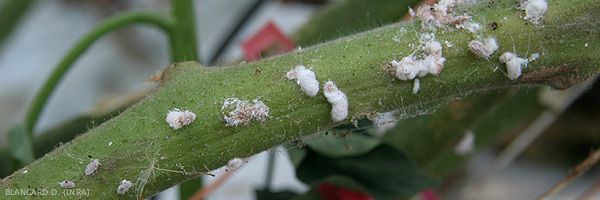
Scale insects
- Nature of damage
- Biology
- Forms of conservation and / or alternative hosts : P. viburni tolerates cold fairly well and spends the winter as a non-diapausing nymph in the soil. It can be maintained on other alternative hosts, in particular on potatoes, apple trees, lemon trees, grapevines.
- Developmental stages: the eggs (figure 4-1) are laid inside a white waxy ovisac. After hatching, the first instar larvae (Figure 4-2) disperse on infested plants. After the second larval stage (figure 4-3), this insect will form two successive false nymphs in which the males will undergo a metamorphosis. These have the appearance of small winged midges, whose life is ephemeral. Females (Figure 4-4) (Figures 5 and 6), measuring 4 mm in length, do not undergo metamorphosis and therefore do not change shape. The pinkish color of their body is masked by white mealy wax.
- Dispersion in the culture : this cochineal is mainly disseminated by the plant material. The workers during cultivation operations, the animals contribute to its dispersion.
- Favorable development conditions : P. viburni seems to have found in France, in greenhouses, conditions entirely favorable to its development.
- Protection methods
Several protection methods are recommended to control the development of scale insects on tomatoes in France:
- treat the plants before uprooting in the presence of high populations of pests;
- remove and destroy plant debris and crop residues;
- leach with water and treat the walls of shelters, posts, concrete walkways with an insecticide or a contact acaricide;
- disinfect the equipment used in the greenhouse (drip system, boxes, etc.);
- disinfect the substrate reused or the soil.
* Chemical control : As the number of pesticides available for a given use is constantly changing, we advise you to always confirm your choice by consulting the e-phy site of the Ministry of Agriculture and Fisheries which is an online catalog of plant protection products and their uses, fertilizers and growing media approved in France. This also applies to all biological products based on microorganisms or natural substances.





